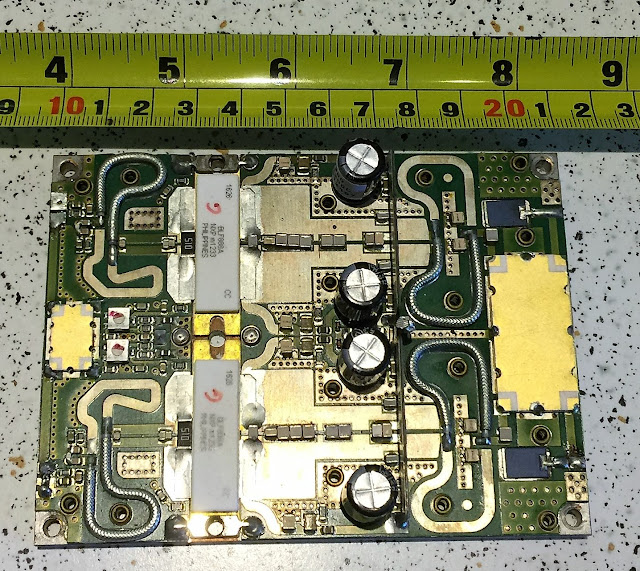Commercial DVB-T Amplifiers and filters and implications for DATV
Commercial DVB-T Amplifiers and filters and implications for DATV (first draft)
Introduction
Commercial solid-state DVB-T amplifiers use about 250 W "pallet" amplifiers; a pair of amplifiers, each using a pair of LMDOS transistors in a single package. The circuit boards are mounted on a piece of thick copper then on a heat sink. To get higher power, 1 to 50 KW, many pallet amplifiers are used in parallel with a system of splitters and combiners. The amplifier output passes through a series of filters, to stay within a standardized spectrum mask to limit adjacent channel interference. To conclude I note some implications for DATV.Pallet amplifers
A typical pallet amplifier is pictured below (bought on eBay). The gold rectangle on the left splits the input to a pair of Doherty amplifiers, while the one on the right combines the amplified signal to the output. The combiner uses a type of circulator to dump RF to a dummy load, the black rectangles on either side of the combiner, that doesn't go to the output, so it does not go to the other amplifier.The white rectangles are the LMDOS transisters in this case BLF888A. Each contains a matched pair of Mosfets. Each amplifier is a modified form of class B, with a pot to adjust the quiescent current for each to improve linearity. Each amplifier has impedance matching on the input and output. A fairly conventional RF amplifier widely used in amateur radio.
LMDOS Transistor
A snip from the data sheet for a modern form of the same transistor is below. It is specifically designed for broadcast TV, with three versions for the three TV bands and runs on 50 V.
Of significant interest is the 150 W at 50 percent efficiency on DVB-T. This would appear to be an anomaly as it is rated as a 750 W device. The anomaly comes down to how the power is measured, a long-standing misunderstanding as to how DVB-T power is measured. I will discuss this in another post, but the 750 W is for single CW carrier, compared to the RMS value of the nearly 8000 carriers in the envelope of an 8 MHz DVB-T channel.
The PAR (peak-to-average ratio) value of 8 dB is the operating parameter of the amplifier, allowing only 8 dB of Crest factor before clipping. Crest factor can be as high as 38 dB. The amplifier deliberately clips the crests to 8 dB. The reason for this is that the Crest Factor is statistical. With a large number of pallet amplifiers, the crests add up potentially to give extremely high peaks, with voltages that would damage RF equipment after the amplifier. A PAR of only 8 dB will create significant intermodulation skirts that need to be filtered out.

Complete transmitter
The block diagram of a high power amplifier using multiple pallet amplifiers and drivers. in this case there are 8 pallets per block and 8 blocks, giving 64 pallets in all. The output would be about 64 x about 250 W or probably 15 kW total.There is a filter to remove the shoulders or skirts to an acceptable level. The filters use up to 8 cavity filters of different types, I believe including some notch filters per my 70 cm amplifier filter.
There is also a harmonics filter as cavity filters are resonant at odd harmonics of the main signal. Power and cooling are major issues.
TV stations run with at least one reserve amplifier, sometime another at a different site, such as at another channels tower.
https://cdn.rohde-schwarz.com/pws/dl_downloads/dl_common_library/dl_news_from_rs/172/n172_mpeg2.pdf
Spectrum masks
Spectrum masks are mandated for commercial TV stations to limit adjacent channel interference, as shown below.The spectrum masks are achieved using the cavity filters discussed in the last section. There are two masks, Critical masks with a 50 dB limit for skirt for stations that have adjacent channels, as is common in metropolitan areas. Uncritical masks are less strict at 40 dB for skirts, and are used for isolated stations common in rural areas where the interference is less of a problem.
Measuring sideband emissions of T-DAB and DVB-T transmitters for monitoring purposes Rec. ITU-R SM.1792 1, RECOMMENDATION ITU-R SM.1792
Implications for DATV
There are a number of implications for DATV particularly those using DVB-T.DVB-T amplifier efficiency is higher than commonly understood because of the different way it is measured, just like the difference between measurement of CW and SSB amplifiers.
Commercial DVB-T amplifiers are driven much harder than most DATV amplifiers, with low PAR to clip crests, but create bigger shoulders or skirts. This can be done with DATV amplifiers, provided filters are used.
Filters to remove intermodulation skirts or shoulder are mandatory. They could be used in DATV to reduce interference and to get more power. They are probably necessary for multiple lower bandwidth channels, 2 MHz, adjacent in a band.



Comments
Post a Comment